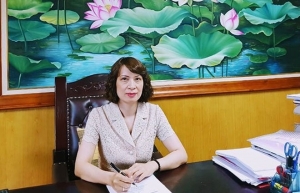Healthcare service quality must meet global standards
Last year, the Ministry of Health (MoH) submitted to the National Assembly the revised Law on Medical Examination and Treatment with a patient-centred perspective. This law, which took effect in January, will further motivate hospitals to actively improve service quality and ensure patient safety.
 |
| Tran Van Thuan, deputy Minister of Health |
In the context of strong developments at home and abroad, especially Industry 4.0, which has a profound impact on the entire society, the application of IT will help hospitals operate more safely and effectively. Therefore, hospitals need to promote the implementation of electronic medical records, apply IT solutions in improving medical treatment processes such as making medical appointments on applications, non-cash payments, and interconnected hospital test results, electronic prescriptions and others.
For a decade, the health sector has effectively implemented quality management of such services at hospitals, deploying a set of criteria for evaluating hospital quality, and guiding the medical examination process in the direction of applying the most convenient medical examination process, reducing inconvenience, and procedural requirements for patients with health insurance card.
Hospitals at all levels, including district-level ones, after applying over 80 quality criteria, have clearly seen increasing improvement in the quality of exam and treatment. The MoH has chosen Thai Nguyen Central Hospital as the venue for the Quality Management - Patient Safety Forum to enable participants to experience one of the hospitals actively improving service quality and achieving very encouraging results.
If hospitals do well in quality management and patient safety, the medical treatment system will develop sustainably and serve the people better. To better meet the people’s growing medical needs, the health sector has been continuously making efforts to change.
The achievements of the health sector have put Vietnam in the top 10 countries quickly completing the UN’s Millennium Development Goals in health. In addition, to improve the quality of treatment for people, the health sector has caught up with the medical level of countries in the region and the world, increasing the application of high technology in such services, moving towards specialising in fields to improve the quality of medical services.
The system of hospitals from central to local levels has invested in high-tech equipment and techniques such as CT scans, MRIs, radiotherapy, genetic technology, early cancer screening, and much more besides. Through the Satellite Hospital Project, many lower-level hospitals have received transfer of new, and modern technology, improving their reputation and expertise, attracting local patients and contributing to reducing the overload at central hospitals.
In particular, in obstetrics and paediatrics, 98 per cent of patients have been examined and treated at lower-level hospitals, instead of being transferred to higher-level ones.
Telehealth has also been promoted. Currently, the system has connected 1,400 points among hospitals of different levels to improve the quality of lower-level medical care, making it easier for upper-level experts to provide support quickly, promptly and effectively for lower-level doctors in implementation of difficult cases with requirements of high techniques, thus helping people enjoy high technical achievements right in their own localities.
In addition, since 2013, the MoH has piloted the project to send young volunteer doctors to mountainous, remote, border, island, and economically disadvantaged areas - particularly difficult societies to deploy and promote many difficult techniques and complicated cases.
Such solutions have made an important contribution to narrowing the gap in healthcare quality among levels, and attracting locals to stay at home for treatment, instead of going to Singapore, the US and Japan.
This trend shows that people are enjoying high technology at home. People with high technical needs have been largely met at medical specialised centres in Hanoi and Ho Chi Minh City because our treatment level is on par with advanced countries in the region. On the contrary, we have seen more and more foreign patients, even from developed countries, coming to Vietnam for medical examination and treatment due to high efficiency and reasonable costs.
The MoH has been continuing to promote administrative procedure reform through strongly simplifying health insurance procedures, reducing examination time, waiting time, and applications of technology.
Vietnamese hospitals need to make more efforts to meet basic quality standards. Hospitals with better conditions will apply advanced quality standards. If hospitals actively improve quality, we believe that in the near future, Vietnam’s system will have more hospitals meeting regional and global standards, thereby attracting foreigners who can afford to use services here.
 | Demand fuelled for high-quality healthcare services Vietnam’s healthcare market is emerging as a fertile land for foreign investors to cash in on its tremendous potential. |
 | Increasing private investment in healthcare – A long journey ahead The healthcare sector has yet to live up to expectations despite efforts to attract investment. Nguyen Thi Lien Huong, Deputy Minister of Health, talked with VIR’s Bich Thuy about the steps needed to make improvements. |
 | Healthcare models for sustainability era The health sector had a busy 2023, with many important foundations laid to strengthen the quality, resilience, and sustainability into the future. |
What the stars mean:
★ Poor ★ ★ Promising ★★★ Good ★★★★ Very good ★★★★★ Exceptional
Themes: Healthcare Platform
- Takeda Vietnam awarded for ongoing support of Vietnam’s sustainability efforts
- Self-care signals shift towards sustainable healthcare
- DKSH to acquire Vietnamese healthcare distributor Biomedic
- Two national hospitals expand capacity with new facilities
- Vietnam moves to enhance disease prevention, equity, and sustainability
Related Contents
Latest News
More News
- Double-digit GDP growth within reach with shift to higher-value expansion (January 06, 2026 | 08:33)
- Takeda Vietnam awarded for ongoing support of Vietnam’s sustainability efforts (December 31, 2025 | 21:00)
- Vietnam's retail market tops $269 billion in 2025 amid e-commerce boom (December 31, 2025 | 19:00)
- Stronger legal framework urged as trade fraud surges online (December 31, 2025 | 18:58)
- FPT exports first chip shipment to Japan (December 31, 2025 | 10:47)
- AkzoNobel rolls out sustainability campaign “It All Adds Up” for the wood sector (December 31, 2025 | 09:23)
- Textile apparel firms deliver robust earnings despite global tariff pressures (December 30, 2025 | 10:09)
- Businesses ramp up production as year-end orders surge (December 30, 2025 | 10:05)
- Vietjet chairwoman awarded Labour Hero title (December 29, 2025 | 13:06)
- How to unlock ESG value through green innovation (December 29, 2025 | 10:03)

 Tag:
Tag:
















 Mobile Version
Mobile Version